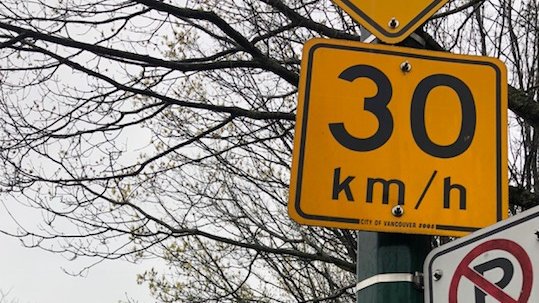On a personal side note, I became involved in local community advocacy and ultimately civic politics after my close friend and good neighbour Paul Tynes was hit by a speeding minivan while he was walking across Prior Street. He suffered a traumatic brain injury and months in hospital and the neurological trauma ward. The long term impacts of those injuries ultimately claimed his life.
The idea of slowing speed limits down could be elaborated upon in a more detailed blog post but there’s lots of evidence to support the why, and articulated in #VisionZero work being done around the world. The gist of the ask, take the 80% or so of residential roads in the City (defined by lack of a centre line), lower the speed from the default 50km/h to 30km/h for improved livability, more comfortable public realm and drastically improved survivability in the event a pedestrian is struck by a car.
#VisionZero residential speed limit improvements have been implemented in Seattle, Portland, and in cites across North America and Europe.
Building on work done by the previous Vancouver council and advocacy by local governments across the province at Union of BC Municipalities, this motion tackled one of the roadblocks (no pun intended) the province threw at this work by way of the Motor Vehicle act – which effectively mandates to change the speed limits the city would need to post signage on every block of every street. This motion flips the ask that the province amend the MVA to allow us to set our own city-wide default speed limit (and conversely post higher speed limits on select arterials as necessary). The motion also makes provision for local pilot areas.
UPDATE This motion passed handily at Council and went on to pass after vigorous debate at UBCM. To date, the province has not given local governments the ability to set default speed limits.
WHEREAS 1. Currently, the BC Motor Vehicle Act stipulates a speed limit of 50 kilometers per hour within city limits. 2. The probability of pedestrian survivability is about 90% if struck by a motor vehicle travelling at 30km per hour, survivability is reduced to 20% if struck by a vehicle at 50 km per hour. 3. Today, Vancouver has 30kmph limit on designated bike routes, in school and playground zones and along a portion of Hastings Street, however a blanket speed limit reduction would require changes to the MVA, or significant signage and roadwork by the city. 4. Lower speed limits are more compatible with active transportation, and creating safer, better engaged, and more inclusive communities. 5. In 2012, The City of Vancouver’s Pedestrian Safety Study identified that mixed mode roadways, allowing for shared use of space by motor vehicles, pedestrians, and bicyclists without lane assignment (for example Granville Island) serves to reduce speed limits, while improving public realm, social connectivity, and increasing active transportation. 6. In 2016, The City of Vancouver endorsed Vision Zero, an international framework and project that prioritizes road traffic safety over speed or convenience and emphasizes that the responsibility for safety is shared by transportation system designers and road users. 7. In 2018, as part of their position paper, Modernizing the BC Motor Vehicle Act the British Columbia-based Road Safety Law Reform Group recommended: “A default provincial speed limit of 30 km/h for local (no centre line) streets should be included in the MVA, with municipalities enable to increase speed limits on local streets in a case by case basis by bylaws and posted signage.” 8. In 2018, the provincial government’s B.C. Community Road Safety Toolkit recommended lower speed limits in downtown areas and residential roads. THEREFORE BE IT RESOLVED THAT Council re-affirm the City’s commitment to Vision Zero, and a street system with no fatalities or serious injuries involving road traffic. THAT Council direct staff to develop a pilot 30kmph speed limit demonstration project, focused on mixed mode use, reduced speeds, and complimentary road design with a mechanism to record and analyze before and after data. THAT Council direct staff to identify a local street, area, or areas within the city to pilot a 30kmph speed limit demonstration project and report back with implementation strategy, timing, and budget as well as proposed road design changes by Q3 2019. THAT Council submit the following resolution along with above preamble (articles 1, 2, 4, 7, 8) for consideration at the LMLGA and presentation at UBCM: “Therefore be it resolved that the UBCM lobby the province to change the Motor Vehicle Act to a default speed limit of 30kmh for local streets with municipalities enabled to increase speed limits on local streets in a case by case basis by bylaws and posted signage.”

